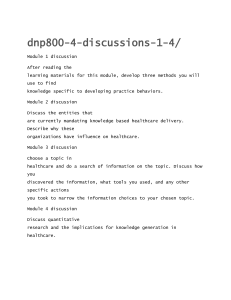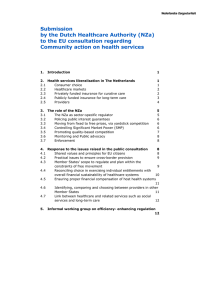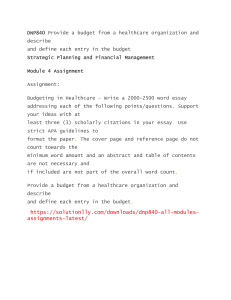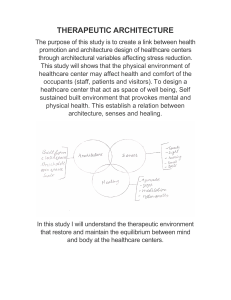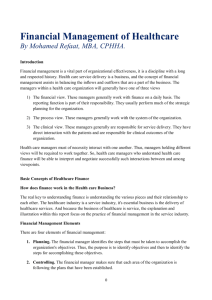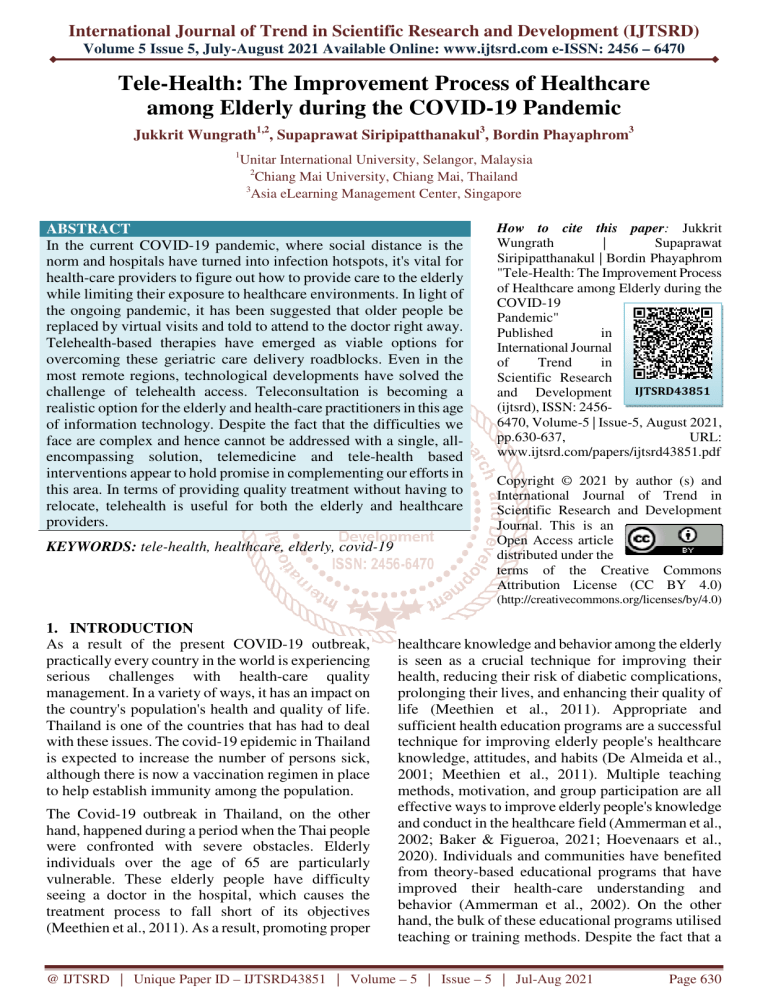
International Journal of Trend in Scientific Research and Development (IJTSRD)
Volume 5 Issue 5, July-August 2021 Available Online: www.ijtsrd.com e-ISSN: 2456 – 6470
Tele-Health: The Improvement Process of Healthcare
among Elderly during the COVID-19 Pandemic
Jukkrit Wungrath1,2, Supaprawat Siripipatthanakul3, Bordin Phayaphrom3
1
Unitar International University, Selangor, Malaysia
2
Chiang Mai University, Chiang Mai, Thailand
3
Asia eLearning Management Center, Singapore
ABSTRACT
In the current COVID-19 pandemic, where social distance is the
norm and hospitals have turned into infection hotspots, it's vital for
health-care providers to figure out how to provide care to the elderly
while limiting their exposure to healthcare environments. In light of
the ongoing pandemic, it has been suggested that older people be
replaced by virtual visits and told to attend to the doctor right away.
Telehealth-based therapies have emerged as viable options for
overcoming these geriatric care delivery roadblocks. Even in the
most remote regions, technological developments have solved the
challenge of telehealth access. Teleconsultation is becoming a
realistic option for the elderly and health-care practitioners in this age
of information technology. Despite the fact that the difficulties we
face are complex and hence cannot be addressed with a single, allencompassing solution, telemedicine and tele-health based
interventions appear to hold promise in complementing our efforts in
this area. In terms of providing quality treatment without having to
relocate, telehealth is useful for both the elderly and healthcare
providers.
KEYWORDS: tele-health, healthcare, elderly, covid-19
How to cite this paper: Jukkrit
Wungrath
|
Supaprawat
Siripipatthanakul | Bordin Phayaphrom
"Tele-Health: The Improvement Process
of Healthcare among Elderly during the
COVID-19
Pandemic"
Published
in
International Journal
of
Trend
in
Scientific Research
IJTSRD43851
and Development
(ijtsrd), ISSN: 24566470, Volume-5 | Issue-5, August 2021,
pp.630-637,
URL:
www.ijtsrd.com/papers/ijtsrd43851.pdf
Copyright © 2021 by author (s) and
International Journal of Trend in
Scientific Research and Development
Journal. This is an
Open Access article
distributed under the
terms of the Creative Commons
Attribution License (CC BY 4.0)
(http://creativecommons.org/licenses/by/4.0)
1. INTRODUCTION
As a result of the present COVID-19 outbreak,
practically every country in the world is experiencing
serious challenges with health-care quality
management. In a variety of ways, it has an impact on
the country's population's health and quality of life.
Thailand is one of the countries that has had to deal
with these issues. The covid-19 epidemic in Thailand
is expected to increase the number of persons sick,
although there is now a vaccination regimen in place
to help establish immunity among the population.
The Covid-19 outbreak in Thailand, on the other
hand, happened during a period when the Thai people
were confronted with severe obstacles. Elderly
individuals over the age of 65 are particularly
vulnerable. These elderly people have difficulty
seeing a doctor in the hospital, which causes the
treatment process to fall short of its objectives
(Meethien et al., 2011). As a result, promoting proper
healthcare knowledge and behavior among the elderly
is seen as a crucial technique for improving their
health, reducing their risk of diabetic complications,
prolonging their lives, and enhancing their quality of
life (Meethien et al., 2011). Appropriate and
sufficient health education programs are a successful
technique for improving elderly people's healthcare
knowledge, attitudes, and habits (De Almeida et al.,
2001; Meethien et al., 2011). Multiple teaching
methods, motivation, and group participation are all
effective ways to improve elderly people's knowledge
and conduct in the healthcare field (Ammerman et al.,
2002; Baker & Figueroa, 2021; Hoevenaars et al.,
2020). Individuals and communities have benefited
from theory-based educational programs that have
improved their health-care understanding and
behavior (Ammerman et al., 2002). On the other
hand, the bulk of these educational programs utilised
teaching or training methods. Despite the fact that a
@ IJTSRD | Unique Paper ID – IJTSRD43851 | Volume – 5 | Issue – 5 | Jul-Aug 2021
Page 630
International Journal of Trend in Scientific Research and Development @ www.ijtsrd.com eISSN: 2456-6470
number of efforts have been developed to encourage
healthy habits.
Several studies have shown that the notion of quality
development, or “PDSA,” has been accepted as the
key concept and method for the development of
health education programs (Cleghorn & Headrick,
1996). PDSA is a concept that emphasizes methodical
operation with the purpose of continual improvement.
It is not simply focused on planning. Administrative
procedures executed in accordance with PDSA
guidelines are systematic and comprehensive,
resulting in productive activities that are appropriate
for the firm (Nordberg, 2021). The state of the
organization is investigated in areas such as
manufacturing and personnel, with the results being
utilized as input for planning and developing
operating guidelines. Periodic evaluations enable the
plan to be updated in response to changing
circumstances (Nordberg, 2021& Rogers, 2021).
Furthermore, the project's success analysis identifies
the operation's faults and strengths, and serves as a
lesson for future operations; at this stage, it is feasible
to make modifications and make actual progress. As a
result, there is potential for more appropriate and
directional development. The operation, whether it's
through productivity tools, quality improvements, or
even activity management within the company.
Proper planning based on the analysis of relevant data
is a good place to start, and following the plan will
lead to success and achievement of the goals, but it
will also necessitate periodic monitoring of progress
or problems in order to obtain information that can be
used to align the plan with the situation (Rogers,
2021). Each time an operation is completed, the
program automatically reviews and summarizes the
lessons learned for advantages, disadvantages, or
areas for improvement in order to make the next
round easier to achieve better results, and all of this is
done in accordance with the PDSA circuit, which is at
the heart of continuous improvement. Researchers
have the aim of producing health education programs
that are as effective and focused as feasible by
considering and preparing according to PDSA
standards. This is in line with the covid-19 pandemic,
which has made it impossible for the general public,
notably the elderly and diabetic patients, to access
healthcare. The researchers used the "Tele-health
concept" to build health education programs
employing social media, including line apps and
telephone consultations, as the primary research
methods (Nordberg, 2021).
We explore how tele-health -based interventions
might help sustain efficient delivery of care for the
elderly throughout the ongoing covid-19 pandemic,
and how the old would be content with participation
in this well-being program, which will be centered on
the notion of "Patient Satisfaction"
2. Improvement Process of Healthcare Quality
Improvement
2.1. Plan-Do-Study-Act (PDSA) Cycle for
Improvement
The Plan-Do-Study-Act (PDSA) method is a
methodical approach to obtaining valuable knowledge
and learning to enhance a product, process, or service
over time. This integrated learning-improvement
paradigm. The plan is the first phase in the cycle.
Identifying a goal or purpose, establishing a theory,
defining success measures, and putting a plan into
action are all part of this process (Donnelly & Kirk,
2015). These actions are followed by the Do stage,
which involves putting the plan's components into
action, such as manufacturing a product. The next
step is the study, in which the plan's validity is tested
by looking for indicators of progress and success, as
well as difficulties and opportunities for
improvement. The Act stage completes the cycle by
incorporating the knowledge gained throughout the
process. This knowledge can be used to change the
aim, change the methodology, reformulate a theory,
or expand the learning improvement cycle from a
small-scale experiment to a broader implementation
Plan. These four processes can be performed
indefinitely as part of a never-ending cycle of
progress and learning (Cleghorn & Headrick, 1996;
Donnelly & Kirk, 2015).
The PDSA model is a four-stage problem-solving
strategy for improving a process or bringing about
change. Customers, both internal and external, should
be involved in the PDSA cycle since they may
provide feedback on what works and what doesn't.
Because the client defines quality, it seems sense to
involve them as much as possible in the process to
increase the acceptability of the final producthealth
(Donnelly & Kirk, 2015; Leis & Shojania, 2017).
Plan: Only a few key questions should be considered
at this time. • What exactly are you seeking to
achieve? It's referred to as the desired statement. •
This is supported by the question, "What is the
problem?" After that, you must answer the following:
• How do you know you have a problem? To answer
this question, baseline measurements are required.
These give a clearer picture of the problem and its
scope (Leis & Shojania, 2017). It's also critical to
learn more about the problem's likely or actual cause.
As a result of the preceding considerations, a solution
description is naturally formulated. The following
step is to choose and describe the solution's short,
medium, and long-term characteristics. The plan for
@ IJTSRD | Unique Paper ID – IJTSRD43851 | Volume – 5 | Issue – 5 | Jul-Aug 2021
Page 631
International Journal of Trend in Scientific Research and Development @ www.ijtsrd.com eISSN: 2456-6470
successful implementation must be described and
written down, including who will do what, why they
will do it, and when they will do it. The progress
review process relies heavily on these roles and
responsibilities, as well as accountabilities and
targets. Then you must decide how you will measure
your success. It's critical to consider predictions, or
what we expect to see and why we expect to see it.
What are the most likely system-wide effects and
repercussions? (Leis & Shojania, 2017; Donnelly &
Kirk, 2015).
Do: This is where we put the change, test, or
intervention into action and track its progress. To
capture the data trend, it's critical to start at a given
time and gather measurements over a period of time.
Keeping note of difficulties, changes, and unexpected
observations is crucial. Use a run chart, which is a
graphical representation of our data that is plotted in
some order. The horizontal axis is commonly used to
depict a time scale (days, weeks, or months), but it
can also be used to show successive patients, visits, or
treatments. On the vertical axis, the quality indicator
under investigation is located (e.g. infection rate,
number of patients falls, readmission rate) (Donnelly
& Kirk, 2015; Leis & Shojania, 2017).
Study: This is essentially about examining or
evaluating your data, as well as the process itself. The
following are some critical considerations to consider
during this step:
Was the outcome close to what we predicted?
Did everything go according to plan?
What were the key takeaways?
Act: The act is vital in that it requires you to assess
what protections and procedures are in place to
guarantee that whatever solution or solutions you
have discovered remain effective, so questions like
"What modifications are required to process?" are
important. Is there a clear path to follow? Inquire
about your willingness to make another adjustment,
which will lead to the development of a PDSA cycle
approach (Leis & Shojania, 2017). This third
component is crucial for PDSA implementation since
research suggests that small incremental changes
inside a complex system are more likely to result in
overall positive effects. It's possible to become caught
up in a never-ending loop of little adjustments.
However, it is critical to assess readiness for further
change, which is aided by PDSA cycles (Donnelly &
Kirk, 2015).
The PDSA cycle is at the heart of continuous
improvement because it is a reinterpretation of the
scientific method for use in the business. Healthcare
as a setting for health professions education
educational institutions should create the best “quality
learning” environments for students by creating close
partnerships with healthcare organizations that
promote employee development. One of the most
important effects of both enterprises becoming
"learning" organizations and forming a connection
will be the integration of individual and
organizational learning processes. The PDSA cycle is
a learning theory that can be used to help people and
organizations grow. It covers topics such as
transformation and action/reflection, which are
common in well-accepted theory on individual and
organizational learning (Cleghorn & Headrick, 1996).
The PDSA cycle as a learning theory is presented
with one set of implications. It proposes a new way of
thinking about learning evaluation that goes beyond
the traditional emphasis on judgment. Incorporating
the PDSA cycle into health professions education has
huge promise. The historical importance of the
scientific method in healthcare, the relationship
between clinical education and practice, recent
advances in our ability to define and measure health
outcomes, emerging pressures for change in
healthcare and education, and the PDSA cycle's
compatible multiple functions are all contributing
factors to this potential (Cleghorn & Headrick, 1996).
In healthcare, quality improvement is a method for
achieving great results by combining evidence-based
medicine with the best clinical expertise to satisfy the
requirements and expectations of patients (Martinez,
2021). Several key quality improvement activities are
included in this definition, including: 1) gaining a
better understanding of the sources of both systematic
and unwanted and unnecessary variation, 2)
implementing cost-effective strategies to reduce
unwanted variation, and 3) developing organizationalwide knowledge on structured approaches to change
processes and improve outcomes. These crucial
processes are integrated into quality improvement in a
way that distinguishes the discipline. To better
understand variance and improve results, a systems
approach is required. Continuous improvement
requires data-driven approaches and regular review to
be implemented properly and efficiently. Continuous
learning is necessary for a company that values
management through teamwork, strategic planning
leadership, alignment of support services, suppliers,
and distributors, and outcomes in reflection. The
emphasis on implementation in everyday practice is
the single most important element that distinguishes
quality improvement from standard evaluative
research. Some have named this technique "real-time
science" (Speroff et al., 2004). Nonetheless, the goal
of quality improvement research is to create
generalizable information that may be used in other
settings and under various situations from the one
@ IJTSRD | Unique Paper ID – IJTSRD43851 | Volume – 5 | Issue – 5 | Jul-Aug 2021
Page 632
International Journal of Trend in Scientific Research and Development @ www.ijtsrd.com eISSN: 2456-6470
described in this issue's study. As a result, the quality
movement involves the creation of new methods and
statistical techniques to assess quality progress. The
core components of plan-do-study-act (PDSA) quality
improvement real-time science and traditional
research methodology excellence standards are
surprisingly comparable. There are parallels between
the two courses because they are both based on the
scientific process. In quality improvement, the
scientific approach is interlaced in sequential
applications of learning cycles known as PDSA
cycles (Speroff et al., 2004).
2.2.
Tele-health
Tele-health is a term that is used interchangeably with
telemedicine and tele-health to describe the use of
medical information that is shared from one place to
another through electronic communication to improve
a patient's health. The purpose of this article is to
describe policy-relevant trends in telemedicine
adoption, summarize the current state of the
telemedicine evidence base, and assist physicians,
other healthcare professionals, and researchers in
identifying essential telemedicine research objectives.
To fully realize the promise of telehealth in
addressing socially desired goals like the quadruple
aim in healthcare: improving patient experience,
improving population health, lowering per capita
healthcare expenditures, and improving the
experience of providing treatment, further study is
required (Tuckson et al., 2017).
Three interrelated trends are now shaping telehealth.
The first is the shift in telehealth's use from
improving access to healthcare to providing
convenience and, ultimately, financial savings. The
second is the expansion of telehealth to address
episodic and chronic disorders in addition to acute
diseases. The third trend is the expansion of
telemedicine from hospitals and satellite clinics to the
home and mobile devices. From the perspective of
patients, the primary purpose of telehealth is to
improve access to care, and it has typically enhanced
access to healthcare for conditions and groups for
which care was not previously available (Dorsey &
Topol, 2016). The first and most consistent uses of
tele-health were programs to provide therapy to
people in the military, jails, and rural areas. In the
same way that the Internet has made travel, shopping,
and banking more accessible, it is also making
healthcare more accessible. Many organizations, from
academic health institutes to startups, now offer lowcost virtual visits (available 24 hours a day, 7 days a
week) for the "most common, most annoying, most
inconvenient" conditions. In comparison, a 20-minute
visit with a physician takes an average of 20 days to
schedule, and the session takes 2 hours to complete
owing to travel and wait time. Given the increased
interest in bending the cost curve, tele-health may
become more prevalent in delivering intensive
services to the 20% of people who account for 80% of
healthcare spending. “Traditionally, tele-health has
been considered as a tool to increase access to
services,” according to the US Senate Committee on
Finance, “but attention is developing to explore if
tele-health has the potential to cut healthcare costs”
(Dorsey & Topol, 2016; Tuckson et al., 2017).
More recently, telemedicine has expanded to include
care for episodic disorders such as sinusitis, utilizing
a range of care models such as physician aides
visiting schools, video calls, phone calls, and online
algorithms. Until recently, tele-health applications for
chronic conditions were limited to asynchronous
monitoring (e.g., text message) or phone support,
with the exception of mental health. According to a
2012 research, only 10 of 141 randomized, controlled
trials of telemedicine therapy for chronic conditions
involved videoconferencing with a clinician. Despite
the absence of evidence, tele-health is becoming more
popular for a range of chronic conditions, which
affect 140 million people in the US and account for
80% of healthcare spending. Future versions will add
rich data transfer from remote monitoring (through
wearable sensors and mobile diagnostic devices like
electrocardiograms), patient education, and regular
virtual and in-person visits from doctors, nurses,
therapists, and social workers to today's
predominantly conversational approach (Dorsey &
Topol, 2016; Tuckson et al., 2017).
2.3. The Role of Tele-health in the Disasters Era
Over the last decade, tele-health, or technology that
supports and encourages long-distance clinical
treatment, education, and health management, has
become increasingly popular. Mobile health apps,
text, and email, as well as live video teleconferencing,
store-and-forward technologies (e.g., radiograph
readings), remote patient monitoring (e.g., intensive
care unit tele-health coverage), and mobile health
apps, are all common modalities. The frequency and
intensity of disasters or incidents that inflict damage,
ecological disruption, loss of human life, or
degradation of health and health services, and
necessitate a response from outside the afflicted
community have increased during the last several
decades (Lurie & Carr, 2018; Zhou et al., 2020).
The coincidence of these seemingly unrelated events
provide an opportunity for creative thinking about
how telemedicine can help with disaster medical
response. When key infrastructure, such as electricity,
internet connectivity, hospitals, clinics, and clinician
@ IJTSRD | Unique Paper ID – IJTSRD43851 | Volume – 5 | Issue – 5 | Jul-Aug 2021
Page 633
International Journal of Trend in Scientific Research and Development @ www.ijtsrd.com eISSN: 2456-6470
access, is disrupted, telehealth presents both
challenges and opportunity. Hurricane Maria, which
slammed Puerto Rico in 2017, highlighted some of
these challenges and opportunities. Despite the fact
that the Centers for Medicare & Medicaid Services
(CMS) restricts financing to services delivered in
rural areas, tele-health is more concerned with care
delivery than with location. Tele-health is becoming
more common in military health systems, particularly
in forward-deployed and difficult-to-reach places.
Congress has ordered the Department of Defense to
improve telehealth services across the military
healthcare system by 2018 (Lurie & Carr, 2018). The
Department of Veterans Affairs has revealed plans to
roll out telehealth across the country, allowing for
“anywhere to anywhere” care. Stroke consultations in
emergency rooms and telemedicine coverage of
intensive care units are two well-known instances.
Tele-behavioral healthcare, which allows mental
health care to be delivered from a distance, is also
popular (Lurie & Carr, 2018). The need for safe food,
water, shelter, and clothing is common among
disaster survivors. Disasters usually result in an
increase in medical demand that surpasses local
capacity. Timely care saves lives and prevents
people's and communities' health from deteriorating
further. Medical teams may be dispatched to provide
crisis care, decompress emergency rooms, care for
nursing home residents, and provide general and
mental health services. Despite its potential to change
medical response, tele-health has been neglected in
disasters and everyday clinical practice due to
administrative (licensing, credentialing) obstacles.
Despite the fact that telehealth has the potential to
alter medical response, it has been underutilized in
catastrophes, as well as in routine clinical practice,
owing to administrative (license, credentialing) and
reimbursement hurdles (Lurie & Carr, 2018; Wosik et
al., 2020; Zhou et al., 2020).
The COVID-19 epidemic continues to pose a
significant public health threat around the world, and
the United States is not immune. The COVID-19
pandemic has far-reaching implications in a variety of
areas, including global health security, economics,
and healthcare delivery in low- and middle-income
countries, to mention a few. In order to effectively
contain the epidemic, responses have been stepped
up. On the other hand, national health authorities and
other stakeholders must continue to ensure that highquality healthcare services are available. Innovation is
more crucial than ever in the battle against COVID19, and we must continue to find ways to ensure
country-compatible measures and regulations
(Okereke et al., 2021). To ensure a proactive
response, a certain technique is also required.
Increased testing capacity, cross-border cooperation
and collaboration, effective community participation,
and infection prevention and control measures like
physical distance and proper hand and cough
etiquette/respiratory hygiene. As a result, the load on
already vulnerable healthcare systems would be
eased. This will allow for a sufficient response to the
unprecedented COVID-19 epidemic while also
ensuring that healthcare service is not hindered
(Okereke et al., 2021).
The COVID-19 pandemic may provide an
opportunity to introduce and enhance understanding
of the digital era's prospects across a wide range of
health professionals (Di Carlo et al., 2021). Examine
the challenges that poor countries have in
implementing telehealth services. COVID-19 patients
are already inundating hospitals around the world,
necessitating challenging staffing and resource
allocation considerations. During this public health
crisis' infectious outbreak and the ensuing fear, it is
critical to restructure healthcare delivery. Around the
world, tele-health has emerged as a viable strategy for
protecting frontline healthcare workers and
supporting vulnerable chronic disease patients.
Socioeconomic and racial disparities have inhibited
the efficient deployment of telemedicine in low- and
middle-income countries. However, in both poor and
developed countries, desirable health knowledge and
behavior are frequently overlooked, despite their
importance in the adoption of telemedicine (Butler,
2020; Nair et al., 2020; Neubeck et al., 2020).
2.4. Information technology and social network
with Elderly
The value of information technology in healthcare is
generally recognized, but as medicine becomes more
complex, the sophistication of information technology
tools and processes rises to new heights. Recently, the
healthcare community has voiced a desire to use and
turn huge amounts of healthcare data and information
into value-added "decision quality knowledge."
Despite the well-established importance of
information technology in healthcare, medical
practice is becoming increasingly complex, driving
the sophistication of information technology tools to
new heights.
The emergence of smartphones, tablets, and mobile
applications has had a tremendous impact on health
and healthcare, particularly Line apps, which provide
busy health workers with learning and collaboration
choices as well as peer-to-peer aid and public health
education (Boulos et al., 2014). The successful use of
social media on smartphones is part of how doctors
and patients connect in the twenty-first century.
Instagram, WhatsApp, Facebook, and Line are among
@ IJTSRD | Unique Paper ID – IJTSRD43851 | Volume – 5 | Issue – 5 | Jul-Aug 2021
Page 634
International Journal of Trend in Scientific Research and Development @ www.ijtsrd.com eISSN: 2456-6470
the most popular social media platforms and mobile
applications for sharing and discussing clinical
situations and medical and health knowledge (Kamel
Boulos et al., 2016; Thongprasit, 2020). In the
medical and healthcare industries, a growing number
of social media and networking services have
emerged, and their popularity has grown. The Line
application, which is an instant messaging client with
photo and video sharing features, is the most popular
social networking platform in Thailand, according to
this study. Line is finding a home in medicine and
health, as health workers use hospital-specific and
specialized profiles and groups on these platforms to
communicate and generate social and mobile
learning. The line is a simple and free platform that
allows for clinical and non-clinical communication as
well as mobile learning. The program, which is
available for Android and iOS smartphones, allows
users to exchange text messages and share video,
voice, and image messages and photographs with
their personal and professional learning networks via
the Internet. Line's Group Chat function allows users
to chat and share content with up to 400 people at
once, making it ideal for clinical use. Because of the
numerous benefits of Line, it is the most popular app
among Thais. It has a very high utilization rate of
Line applications for various purposes, especially
among the elderly. However, one of the most
essential reasons for using Line is to improve one's
health (Thongprasit, 2020).
2.5. Patient Satisfaction
Patient satisfaction is a major influence of patients'
behavior and an important indicator of healthcare
quality since it reflects how effectively a provider
meets their customers' expectations (Williams, 1994).
In the healthcare industry, quality of care is an
essential topic in quality assurance and improvement
programs. Although the value of quality has always
been acknowledged in the healthcare industry, it has
risen in recent years as a result of increased quality
insurance, quality improvement activities, and patient
agendas. While quality of care is more important than
cost in healthcare, judging a patient's technical ability,
as well as the immediate repercussions of many
medicines, is difficult. The structure, techniques, and
outcomes of healthcare have all been said to be used
to assess its quality. While the goals of healthcare
efficacy and safety are essentially universal, patientcenteredness, timeliness, efficiency, and equity are
valued differently in different communities and
cultures around the world. Healthcare measurements,
such as process measures, are designed for a variety
of audiences that may desire to use them to acquire,
use, or improve healthcare performance. For all of
these reasons, they must be relevant, scientifically
valid, generalizable, and interpretable (Batbaatar et
al., 2017; Williams, 1994).
Patient satisfaction is a critical indicator of healthcare
quality because it reflects how well a provider
satisfies the client's most important expectations.
Patient happiness has been linked to favorable
outcomes such as increased compliance, lower
medical service consumption, fewer malpractice
lawsuits, and a better prognosis. A proliferation of
surveys focusing solely on patient experience, i.e.,
aspects of the care experience such as waiting times,
the quality of basic amenities, and communication
with healthcare providers, has resulted from the lack
of a solid conceptual foundation and consistent
measurement tool for consumer satisfaction, all of
which help identify tangible priorities for quality
improvement (Batbaatar et al., 2017). Some
academics believe that improving quality from the
perspective of patients delivers more value for money
by improving safety, accessibility, equity, and
comprehensiveness of care, although improving
quality from the perspective of providers may be
more beneficial. Patient happiness is one of the top
concerns for every medical practitioner for a variety
of reasons.
Conclusion
COVID-19's after effects are widely assumed to last
significantly longer than they now do. To limit viral
exposure, vulnerable persons, such as the elderly,
would have to continue to undertake varying degrees
of lifestyle adjustments. Elderly care research would
continue to accommodate to their "new normal" for
the benefit of communities and patients. Despite the
fact that the problems we face are complex and
cannot be solved with a single, all-encompassing
answer, telehealth-based interventions appear to be a
promising way to augment our efforts in this area.
Telehealth is beneficial to both the elderly and
healthcare practitioners in terms of giving quality
treatment without needing to move. Care teams and
health systems all across the world must work
together to design and develop breakthrough
technology in order to include virtual care into cancer
practice. Telemedicine is here to stay, and it will have
a significant impact on geriatric care in the future. It
has the potential to improve the elderly's health and
quality of life while also reducing access to healthcare
services, hospitalization, and costs.
REFERENCES
[1] Ammerman, A. S., Lindquist, C. H., Lohr, K.
N., & Hersey, J. (2002). The efficacy of
behavioral interventions to modify dietary fat
and fruit and vegetable intake: a review of the
@ IJTSRD | Unique Paper ID – IJTSRD43851 | Volume – 5 | Issue – 5 | Jul-Aug 2021
Page 635
International Journal of Trend in Scientific Research and Development @ www.ijtsrd.com eISSN: 2456-6470
evidence. Prev Med, 35(1), 25-41.
https://doi.org/10.1006/pmed.2002.1028
[2]
[3]
[4]
Baker, K., & Figueroa, R. (2021). Motivation,
Attitudes, and Diet Quality Among US Parents
and Adolescents. American Journal of Health
Behavior, 45(1), 125-137.
Batbaatar, E., Dorjdagva, J., Luvsannyam, A.,
Savino, M. M., & Amenta, P. (2017).
Determinants of patient satisfaction: a
systematic review. Perspectives in public
health, 137(2), 89-101.
Boulos, M. N. K., Brewer, A. C., Karimkhani,
C., Buller, D. B., & Dellavalle, R. P. (2014).
Mobile medical and health apps: state of the art,
concerns, regulatory control and certification.
Online journal of public health informatics,
5(3), 229.
[5]
Butler, S. M. (2020). After COVID-19:
thinking differently about running the
healthcare system. Jama, 323(24), 2450-2451.
[6]
Cleghorn, G.D., & Headrick, L.A. (1996). The
PDSA cycle at the core of learning in health
professions education. The Joint Commission
journal on quality improvement, 22(3), 206212.
[7]
De Almeida, M., Graca, P., Afonso, C.,
Kearney, J., & Gibney, M. (2001). Healthy
eating in European elderly: concepts, barriers
and benefits. The journal of nutrition, health &
aging, 5(4), 217-219.
[8]
Di Carlo, F., Sociali, A., Picutti, E., Pettorruso,
M., Vellante, F., Verrastro, V., Martinotti, G.,
& di Giannantonio, M. (2021). Telepsychiatry
and other cutting‐edge technologies in
COVID‐19 pandemic: Bridging the distance in
mental health assistance. International journal
of clinical practice, 75(1).
[9]
Donnelly, P., & Kirk, P. (2015). Use the PDSA
model for effective change management.
Education for Primary Care, 26(4), 279-281.
[10]
Dorsey, E. R., & Topol, E. J. (2016). State of
Tele-health . New England Journal of
Medicine, 375(2), 154-161.
[11]
Hoevenaars, F. P. M., Berendsen, C. M. M.,
Pasman, W. J., van den Broek, T. J., Barrat, E.,
de Hoogh, I. M., & Wopereis, S. (2020).
Evaluation of Food-Intake Behavior in a
Healthy Population: Personalized vs. One-SizeFits-All.
Nutrients,
12(9).
https://doi.org/10.3390/nu12092819
[12]
Kamel Boulos, M. N., Giustini, D. M., &
Wheeler, S. (2016). Instagram and WhatsApp
in Health and Healthcare: An Overview. Future
Internet, 8(3), 37. https://www.mdpi.com/19995903/8/3/37
[13]
Leis, J. A., & Shojania, K. G. (2017). A primer
on PDSA: executing plan–do–study–act cycles
in practice, not just in name. BMJ quality &
safety, 26(7), 572-577.
[14]
Lurie, N., & Carr, B. G. (2018). The role of
Tele-health in the medical response to disasters.
JAMA internal medicine, 178(6), 745-746.
[15]
Martinez Ibañez, V., Ochoa de Echagüen, A.,
Campos, A., & Romea, S. (2021). Creating
efficient
professional
healthcare
organizations. International
Journal
of
Healthcare Management, 1-7.
[16]
Meethien, N., Pothiban, L., Ostwald, S.,
Sucamvang, K., & Panuthai, S. (2011).
Effectiveness of Nutritional Education in
Promoting Healthy Eating among Elders in
Northeastern
Thailand.
Pacific
Rim
international journal of nursing research, 15,
188-202.
[17]
Nair, S. C., Satish, K. P., Sreedharan, J.,
Muttappallymyalil, J., & Ibrahim, H. (2020).
Letter to the Editor: Improving health literacy
critical to optimize global telemedicine during
COVID-19. Telemedicine and e-Health, 26(11),
1325-1325.
[18]
Neubeck, L., Hansen, T., Jaarsma, T.,
Klompstra, L., & Gallagher, R. (2020).
Delivering
healthcare
remotely
to
cardiovascular patients during COVID-19: a
rapid review of the evidence. European Journal
of Cardiovascular Nursing, 19(6), 486-494.
[19]
Nordberg, S. S., McAleavey, A. A., & Moltu,
C. (2021). Continuous quality improvement in
measure development: Lessons from building a
novel clinical feedback system. Quality of Life
Research, 1-12.
[20]
Okereke, M., Ukor, N. A., Adebisi, Y. A.,
Ogunkola, I. O., Favour Iyagbaye, E., Adiela
Owhor, G., & Lucero‐Prisno III, D. E. (2021).
Impact of COVID‐19 on access to healthcare in
low‐and middle‐income countries: current
evidence and future recommendations. The
International journal of health planning and
management, 36(1), 13-17.
[21]
Rogers, A. D., Wallace, D. L., & Cartotto, R.
(2021). A Systematic Review of Quality
@ IJTSRD | Unique Paper ID – IJTSRD43851 | Volume – 5 | Issue – 5 | Jul-Aug 2021
Page 636
International Journal of Trend in Scientific Research and Development @ www.ijtsrd.com eISSN: 2456-6470
Improvement
Interventions
in
Burn
Care. Journal of Burn Care & Research.
[22]
[23]
[24]
Speroff, T., James, B. C., Nelson, E. C.,
Headrick, L. A., & Brommels, M. (2004).
Guidelines for appraisal and publication of
PDSA
quality
improvement.
Quality
Management in Healthcare, 13(1), 33-39.
Thongprasit, J. (2020). Elderly User's Usage
Behavior of Line Application on a Smartphone.
The Journal of KMUTNB, 30(118-129).
Tuckson, R. V., Edmunds, M., & Hodgkins, M.
L. (2017). Tele-health . New England Journal
of Medicine, 377(16), 1585-1592.
[25]
Williams, B. (1994). Patient satisfaction: a
valid concept? Social science & medicine,
38(4), 509-516.
[26]
Wosik, J., Fudim, M., Cameron, B., Gellad, Z.
F., Cho, A., Phinney, D., Curtis, S., Roman, M.,
Poon, E. G., & Ferranti, J. (2020). Tele-health
transformation: COVID-19 and the rise of
virtual care. Journal of the American Medical
Informatics Association, 27(6), 957-962.
[27]
Zhou, X., Snoswell, C. L., Harding, L. E.,
Bambling, M., Edirippulige, S., Bai, X., &
Smith, A. C. (2020). The role of Tele-health in
reducing the mental health burden from
COVID-19. Telemedicine and e-Health, 26(4),
377-379.
@ IJTSRD | Unique Paper ID – IJTSRD43851 | Volume – 5 | Issue – 5 | Jul-Aug 2021
Page 637


